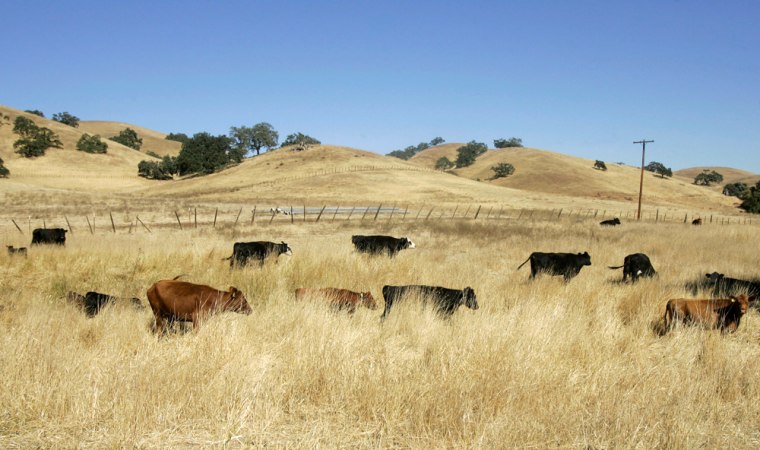California's worst drought in decades is forcing the state's cattle ranchers to downsize their herds because two years of poor rainfall have ravaged millions of acres of rangeland used to feed their cows and calves.
During most dry years, California cattlemen send their herds to places with healthier pastures or buy supplemental feed to sustain their animals until the rainy season. But high fuel prices, a lack of green pastures in California and neighboring states, and the soaring cost of livestock feed have left ranchers little choice but to sell off their mother cows because they can ill afford to feed them.
California ranchers typically raise calves for six to 10 months before selling them to feedlots in Texas, Nebraska, Colorado and other states, but they usually keep mother cows that produce offspring for a decade.
"Cattle producers in the state are facing some serious management decisions," said Matt Byrne, executive vice president of the California Cattlemen's Association. "When you're counting on something from Mother Nature, it's always a risky business."
The number of beef cows on California pastures dropped from 700,000 in January 2007 to 655,000 in January 2008, or 6 percent, according to the U.S. Department of Food and Agriculture. John Nalivka, president the agricultural research firm Sterling Marketing, expects another 6 percent decline when new cattle numbers are reported in January.
Feed them or sell them
The parched, yellow pastures on Joe Gonzales' cattle ranch attest to the severity of a dry spell that is devastating the economic fortunes of many of the state's beef producers.
Gonzales, who normally runs 500 cows on his 2,000-acre spread about 30 miles south of San Jose, cut his herd by half over the past year and may have to sell more if the drought persists.
"When there's no rain, there's no grass," said Gonzales, 65. "As the drought continues, you have to either continue to feed your cattle or sell them. ... It's the worst I've seen it in more than 30 years."
Beef price increases likely
The drought has also hurt out-of-state ranchers who normally bring their cattle to graze on California pastures during the winter rainy season. Some of those cattlemen are selling their cows because feeding them is too costly, Nalivka said.
California, the fourth-largest U.S. beef cattle producer, is downsizing at a time when U.S. beef production is shrinking amid higher fuel and feed prices. The herd reductions will likely mean price increases for consumers.
Gov. Arnold Schwarzenegger declared a statewide drought in May after the state recorded two years of below-average rainfall, a sharp reduction in Sierra Nevada snowpack and its driest spring on record. Late last month, state water officials warned local agencies that their water deliveries could be cut by as much as 85 percent next year.
